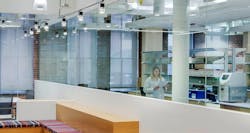Beyond the bench: Meet the modern laboratory facility
Like office workers escaping from the perceived confines of cubicles, today’s scientists have been freed from the trappings of the typical lab bench.
Advances in technology allowing for increased automation have made it so that scientists no longer need to be physically present to watch over all of the complex processes involved in a typical experiment. Data can be analyzed at a desk or online, providing scientists with the opportunity to work from multiple locations.
With so many options, what is the optimal environment for researchers to work? The trend across all workplaces has been toward more open spaces that promote collaboration and interaction among workers, but in laboratories and in supporting offices, there is no one-size-fits-all approach that addresses the needs for each type of task, and each type of worker.
Our client Biogen Idec’s innovative new laboratory space model includes meeting spaces inside laboratories as well as a variety of traditional meeting rooms supplemented with quiet work rooms with lounge furniture, focus rooms with treadmill desks, and social hubs where coffee and multiple seating options are available. Other companies, like Ironwood Pharmaceuticals, want to build a rock climbing wall—a truly alternative work space or, more probable still, a space to quickly blow off steam, regenerate and get back to focused work.
Regardless of space type, the choice is up to the scientist and selected to suit the need. And, more often, the needs are not just for the individual, but for the group as well. The new Allen Institute for Brain Sciences in Seattle, under construction, will feature a multi-story interior atrium connecting the scientific community, activated with bridges, stairs, perches for meeting, overhanging conference rooms and plenty of visibility within and into the adjacent laboratory and lab office spaces.
These hubs and atria are the equivalent of an academic “common room.” They are inherently social, yes, but also places where groups can gather for informal presentations, and chance encounters can take place to talk science and test ideas. In turn, these spaces develop a community that fosters opportunities for innovation. Think start-up culture for the white coat set.
These hybrid spaces also make economic sense: overall costs of both initial construction and subsequent alterations can be considerably less than traditional spaces. Merrimack Pharmaceuticals considered economy, work styles and mobility to create an area of interaction spaces between the laboratory and lab office spaces. This area can host open or closed meeting rooms, allowing for programmatic expansions to either laboratory or office space.
Built with the mechanical flexibility to adapt to laboratory or office space, this zone is not only a great intersection space for collaboration, but also a hedge against the unknown factor of whether or not the needs of the lab or office will expand or contract over time. Another bonus: this space planning model appeals to landlords who must anticipate the natural exchange of tenancies and associated needs over time.
Laboratory spaces are no longer considered technical warehouses for machines and scientific processes. They are environments that support new work styles, evolving technologies, cultures of scientific collaboration, mobility and change. Like the modern office, these labs are part of an integrated community of spaces that respond to the needs and desires of a new generation of talent.
About the Author
With more than 35 years of architectural planning and design experience, Bill Harris is Perkins+Will’s Science + Technology Regional Practice Leader. He brings a personal and mission-driven approach to projects, integrating strategic planning with design to implement innovative architectural solutions for a broad range of clients. His projects have received awards from the American Institute of Architects, Boston Society of Architects, CoreNet New England and the Association of General Contractors. Harris can be reached at [email protected].
Read more posts at Perkins+Will's ideas+buildings blog
About the Author
Perkins and Will
Perkins&Will is a firm of remarkable people who are driven by discovery–through their relationships, research, and design. In the simplest sense, our ideas are the precursors for all of our design work. Perkins&Will’s blog features emerging thought leadership from across the firm, inviting an even greater global dialog around learning, wellness, workplace, sustainability, and everything in between. Follow us on Facebook, Instagram, LinkedIn, Twitter, and Vimeo.
